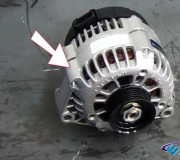The battery warning light isn't for telling when the battery is defective; it's for when it's not getting recharged while driving. That is usually the fault of the alternator. Typically the brushes wear down and cause an intermittent connection.
You can use an ohm meter to test the brushes. It can be done with a voltmeter too. Measure the continuity between or the voltage on the two smaller terminals on the back of the alternator. Voltages must be read with the engine running, not just with the ignition switch on.
I never replaced the brushes on a 2003 but on my '95 Grand Caravan that can be done without removing the alternator from the engine. I just did that on my '88 Grand Caravan daily driver a few months ago. That was an older, larger style alternator that had to be removed, but the whole job took about a half hour. That nine-dollar part was better than buying a whole rebuilt alternator.
In the future you should start a new question rather than piggybacking on this one. I am the only person who will get an automated e-mail directing me back here, and if I don't know the answer, none of the other experts will even see it or have a chance to help.
The voltages on the two smaller terminals might be different than what's described on that page. Chrysler had a REAL nice voltage regulator circuit since 1970 through at least 2000, then for who-knows-why they decided to turn it around and lose some very simple diagnostic characteristics. Instead of 12 volts and "something less than 12 volts" on those two terminals, I believe you should find 0 volts and "something greater than 0 volts".
Regardless, measure those voltages and holler back. We should be able to make sense of them.
Friday, October 5th, 2012 AT 3:56 AM



